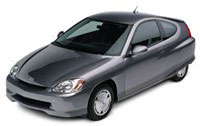Well, there she is. Sleek and silver, dealer plates still on, got her two days ago. Seventy miles per gallon, 700 miles a fill-up. So they say.
Last time I bought a new car — a 1987 Honda Civic wagon that got 35 mpg at its best — I swore I’d keep it until I could double its mileage. Little did I know how close I’d have to cut it. The first car to claim 70 mpg arrived in the showrooms two months ago, just before my old Civic succumbed to terminal rust.

A Honda Insight.
It ticks me off that it took so long. Volvo had a 100-mpg model running around a Swedish test track 25 years ago, using most of the principles designed into my new car. Painstaking aerodynamics. Light materials. Regenerative braking. By the mid-1980s every car company on the planet knew how to make a fuel-efficient vehicle. But the price of gas went down, so they turned out SUVs instead.
In one of his many feel-good, do-little moves, Bill Clinton announced early in his first term that the government would fund the big three U.S. automakers to figure out how to triple gas mileage (though they already knew). They called it the Partnership for a New Generation of Vehicles. A billion tax dollars later, the average mileage of the U.S. vehicle fleet is going down, and the first 70-mpg car on the market is Japanese. It’s the Honda Insight, the car I just bought. The second high-efficiency car, due this June, is also Japanese, the Toyota Prius, which has been on the road in Japan since 1997. I am told that Ford and GM are preparing to offer something similar by 2002 or 2003.
I can’t help but wonder what they did with our billion bucks.
Okay, if you insist, I’ll tell you about my Insight. (Please note: I got no special deal from Honda, I paid full price, and I would have bought a 70 mpg Saturn or Dodge, if I could have.)
It’s a sporty looking thing, smooth in front, stubby in back. It weighs half as much as a normal car, because it’s made largely of aluminum, magnesium and plastic, not steel.
“Doesn’t sound very safe,” says my mother on the phone.
I point out to her that the safety argument is the one people use to justify SUVs, thereby reducing the safety of every normal-size car on the road. If the only way to be safe is to be big, we might as well all get 18-wheelers. My friend Amory Lovins, the car-efficiency guru, assures me that safety has more to do with good design and crushable materials than with weight.
The Insight has only two doors and two seats. There is little luggage room; the back end is full of nickel-hydride batteries. The maximum recommended payload, including driver and passenger, is 365 pounds.
“Doesn’t sound very practical,” says my mother.
Actually, what isn’t practical is to carry a couple of tons of steel along with you at all times in preparation for the one trip in 100 when you have a lot of stuff. My old Civic could hold two large dogs, or several hundred pounds of grain, or two full-size file cabinets, or even, once, a sheep. But mostly it held only me. I live in a household with two Toyota pickups, a minivan, and a Geo Metro. Next time I need to move five passengers or a sheep, I told my mother, I can borrow an appropriate vehicle. A little sharing could save the planet a lot of pollution.
Under the hood the Insight has a tiny three-cycle stratified-charge internal combustion engine with a laughably small lead-acid start-up battery. It also has an electric booster motor that kicks in when you’re accelerating or going uphill. You don’t plug the electric motor into a socket; it runs from the nickel-hydride batteries, which are recharged by the gas engine when you go downhill or put on the brakes.
“So what if you have to pass someone in a hurry?” asks my mother.
Well, I’m not the world’s most aggressive driver, but the thing seems peppy enough for me. I can maintain 65 mph on Vermont’s long uphill stretches, but I have to downshift and sacrifice fuel efficiency to do so.
When you stop for a traffic light, the Insight’s engine automatically shuts off to save gas. It restarts in an instant when you shift into gear. The engine is so quiet that you’re not even aware of the on/off business unless you’re paying attention to the dashboard panel. The panel also tells you when to shift up or down for maximum efficiency, and it shows your instantaneous rate of fuel use and your cumulative mileage for any designated trip and for the life of the car. All this information can be distracting, but you can turn it off.
“Why not wait till they get the bugs out of it?” asks my perfectly sensible mother.
I could have done that within a few months with the Toyota Prius, tested for two years by Japan drivers, made of steel, more normal in weight and size, four doors, four seats (and lower mileage than the Insight, I am told). But the brake lines rusted through on my Civic, and I thought, why not reward the first company to the market with a 21st century car?
It is not the car of my dreams. That one will burn hydrogen in a fuel cell and free us totally from the oil economy, the air pollution, the greenhouse gas emissions. By the time my Insight wears out, that dream car should be here. It would be nice if it were made in America.


